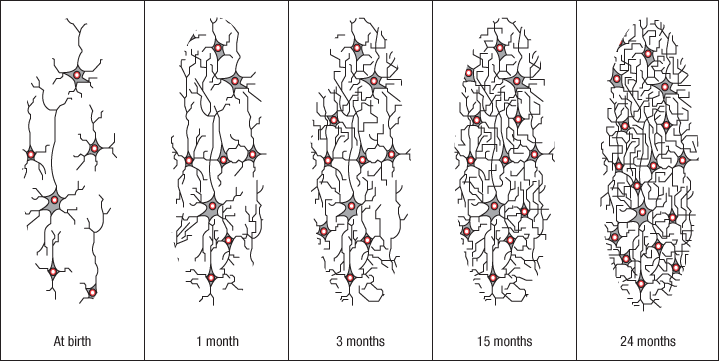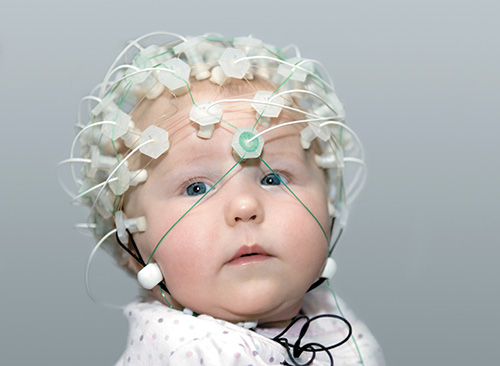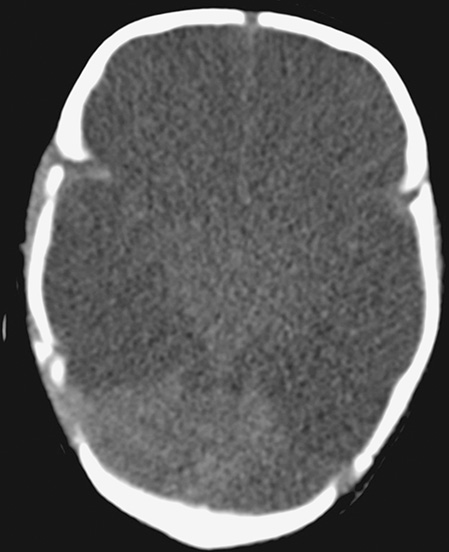The Nervous System and Brain: The Foundations of Development
-
LO2How do the nervous system and brain develop?
When Rina was born, she was the first baby among her parents’ circle of friends. The young adults marveled at the infant, oohing and aahing at every sneeze and smile and whimper, trying to guess at their meaning. Whatever feelings, movements, and thoughts Rina was experiencing, they were all brought about by the same complex network: the infant’s nervous system. The nervous system is composed of the brain and the nerves that extend throughout the body.
Neurons are the basic cells of the nervous system. Figure 5-3 shows the structure of an adult neuron. Like all cells in the body, neurons have a cell body containing a nucleus. But unlike other cells, neurons have a distinctive ability: they can communicate with other cells, using a cluster of fibers called dendrites at one end. Dendrites receive messages from other cells. At their opposite end, neurons have a long extension called an axon, the part of the neuron that carries messages destined for other neurons. Neurons do not actually touch one another. Rather, they communicate with other neurons by means of chemical messengers, neurotransmitters,that travel across the small gaps, known as synapses, between neurons.
Figure 5-3
The Neuron
The basic element of the nervous system, the neuron comprises a number of components.
Source: Van de Graaff, 2000.
Although estimates vary, infants are born with between 100 and 200 billion neurons. In order to reach this number, neurons multiply at an amazing rate prior to birth. At some points in prenatal development, cell division creates some 250,000 additional neurons every minute.
At birth, most neurons in an infant’s brain have relatively few connections to other neurons. During the first two years of life, however, a baby’s brain will establish billions of new connections between neurons. Furthermore, the network of neurons becomes more complex, as illustrated in Figure 5-4. The intricacy of neural connections continues to increase throughout life. In adulthood a single neuron is likely to have a minimum of 5,000 connections to other neurons or other body parts.
Figure 5-4
Neuron Networks

Over the first two years of life, networks of neurons become increasingly complex and interconnected. Why are these connections important?
Source: Conel, 1930/1963.

Using sophisticated measurement techniques scientists are able to determine the nature of neuronal development in infants
Synaptic Pruning. Babies are actually born with many more neurons than they need. In addition, synapses are formed throughout life, based on our changing experiences. What happens to the extra neurons and synaptic connections?
Like a farmer who, in order to strengthen the vitality of a fruit tree, prunes away unnecessary branches, brain development enhances certain capabilities in part by a “pruning down” of unnecessary neurons. As an infant begins to experience the world, neurons that do not become interconnected with other neurons become unnecessary. They eventually die out, increasing the efficiency of the nervous system.
As unnecessary neurons are being reduced, connections between remaining neurons are expanded or eliminated. If a baby’s experiences do not stimulate certain nerve connections, these, like unused neurons, are eliminated—a process called synaptic pruning. The result of synaptic pruning is to allow established neurons to build more elaborate communication networks with other neurons. Unlike most other aspects of growth, then, the development of the nervous system proceeds most effectively through the loss of cells (Johnson, 1998; Mimura, Kimoto, & Okada, 2003; Iglesias et al., 2005; Schafer & Stevens, 2013).
After birth, neurons continue to increase in size. In addition to growth in dendrites, the axons of neurons become coated with myelin, a fatty substance that, like the insulation on an electric wire, provides protection and speeds the transmission of nerve impulses. So, even though many neurons are lost, the increasing size and complexity of the remaining ones contribute to impressive brain growth. A baby’s brain triples its weight during his or her first two years of life, and it reaches more than three fourths of its adult weight and size by age 2.
As they grow, the neurons also reposition themselves, becoming arranged by function. Some move into the cerebral cortex, the upper layer of the brain, while others move to subcortical levels, which are below the cerebral cortex.The subcortical levels, which regulate such fundamental activities as breathing and heart rate, are the most fully developed at birth. As time passes, however, the cells in the cerebral cortex, which are responsible for higher-order processes such as thinking and reasoning, become more developed and interconnected.
For example, synapses and myelinization experience a growth spurt at around 3 to 4 months in the area of the cortex involving auditory and visual skills (areas called the auditory cortex and the visual cortex). This growth corresponds to the rapid increase in auditory and visual skills. Similarly, areas of the cortex related to body movement grow rapidly, allowing for improvement in motor skills.
Although the brain is protected by the bones of the skull, it is highly sensitive to some forms of injury. One particularly devastating injury comes from a form of child abuse called shaken baby syndrome, in which an infant is shaken by a caretaker, usually out of frustration or anger due to a baby’s crying. Shaking can lead the brain to rotate within the skull, causing blood vessels to tear and destroying the intricate connections between neurons. The blood vessels of the retina may bleed (see Figure 5-5).
The results can be devastating, leading to severe medical problems, long-term physical disabilities such as blindness, hearing impairment, and speech disabilities. Some children experience learning disabilities and behavior disorders. In the most severe cases, the shaking leads to death. Estimates of the incidence of shaken baby syndrome range from 600 to 1,400 cases a year in the United States, and 25 percent of babies who are shaken ultimately die (Runyan, 2008; American Association of Neurological Surgeons, 2012; Hitchcock, 2012).
Figure 5-5
Shaken Baby

This CAT scan shows severe brain injury in an infant suspected of being abused by caretaker shaking.
Source: Malung, Bilo, Kuba & van Rijn, 2011.
Environmental Influences on Brain Development. Brain development, much of which unfolds automatically because of genetically predetermined patterns, is also strongly susceptible to environmental influences. Infact, the brain’s plasticity, the degree to which a developing structure or behavior is modifiable due to experience, is a significant attribute of it.
The brain’s plasticity is greatest during the first several years of life. Because many areas of the brain are not yet devoted to specific tasks, if one area is injured, other areas can take over for the injured area. As a result, infants who suffer brain injuries typically are less affected and recover more fully than adults who have experienced similar types of brain injuries, showing a high degree of plasticity. Of course, not even the brain’s inherent plasticity can fully protect against severe injuries, such as those resulting from the violent shaking typical of shaken baby syndrome (Vanlierde, Renier, & DeVolder, 2008; Mercado, 2009; Stiles, 2012).
Infants’ sensory experiences affect both the size of individual neurons and the structure of their interconnections. Consequently, compared with those brought up in more enriched environments, infants raised in severely restricted settings are likely to show differences in brain structure and weight (Cirulli, Berry, & Alleva, 2003; Couperus & Nelson, 2006; Glaser, 2012).
Work with nonhumans has helped reveal the nature of the brain’s plasticity. Studies have compared rats raised in an unusually visually stimulating environment to those raised in more typical, and less interesting, cages. Results of such research show that areas of the brain associated with vision are both thicker and heavier for the rats reared in enriched settings (Black & Greenough, 1986; Cynader, 2000; Degroot, Wolff, & Nomikos, 2005; Axelson et al., 2013).
In contrast, environments that are unusually barren or in some way restricted may impede the brain’s development. Again, work with nonhumans provides some intriguing data. In one study, kittens were fitted with goggles that restricted their vision so that they could view only vertical lines (Hirsch & Spinelli, 1970). When the cats grew up and had their goggles removed, they were unable to see horizontal lines, although they saw vertical lines perfectly well. Analogously, kittens whose goggles restricted their vision of vertical lines early in life were effectively blind to vertical lines during their adulthood—although their vision of horizontal lines was accurate.
On the other hand, when goggles are placed on older cats who have lived relatively normal lives as kittens, such results are not seen after the goggles are removed. The conclusion is that there is a sensitive period for the development of vision. As we noted in Chapter 1, a sensitive period is a specific, but limited, time, usually early in an organism’s life, during which the organism is particularly susceptible to environmental influences relating to some particular facet of development. A sensitive period may be associated with a behavior—such as the development of full vision—or with the development of a structure of the body, such as the configuration of the brain (Uylings, 2006).
The existence of sensitive periods raises several important issues. For one thing, it suggests that unless an infant receives a certain level of early environmental stimulation during a sensitive period, the infant may suffer damage or fail to develop capabilities, an effect that can never be fully remedied. If this is true, providing successful later intervention for such children may prove to be particularly challenging (Gottlieb & Blair, 2004; Zeanah, 2009).
The opposite question also arises: does an unusually high level of stimulation during sensitive periods produce developmental gains beyond what a more commonplace level of stimulation would provide?
Such questions have no simple answers. Determining how unusually impoverished or enriched environments affect later development is one of the major questions addressed by developmental researchers as they try to find ways to maximize opportunities for developing children.
In the meantime, many developmentalists suggest that there are many simple ways parents and caregivers can provide a stimulating environment that will encourage healthy brain growth. Cuddling, talking and singing to, and playing with babies all help enrich their environment. In addition, holding children and reading to them is important, as it simultaneously engages multiple senses, including vision, hearing, and touch (Lafuente et al., 1997; Garlick, 2003).